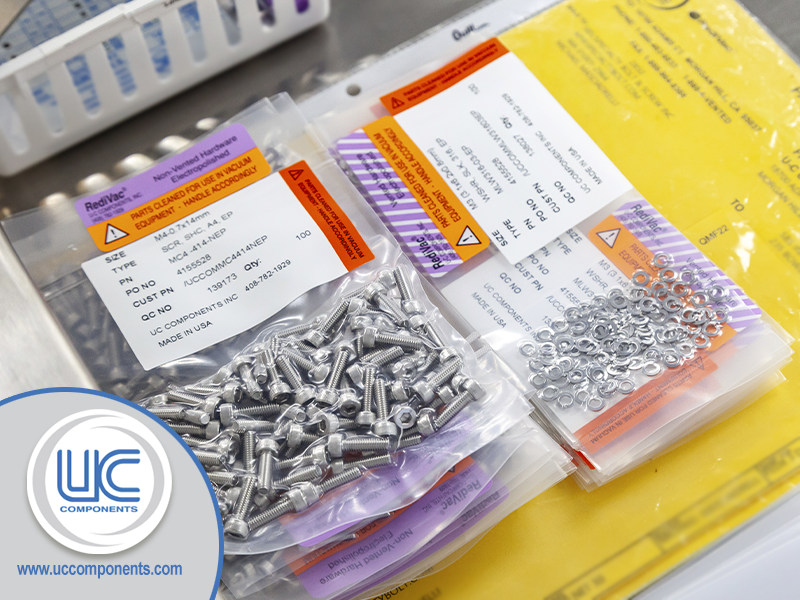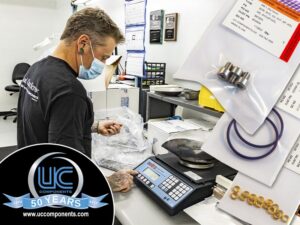Fasteners installed in any piece of equipment need to be long-lasting and able to withstand repeated use (when appropriate).
Coatings and platings are designed for a number of purposes, including but not limited to:
- Galling prevention (stainless to stainless cold welding)
- Improve corrosion resistance
- Improved surface finish
- Cosmetic enhancement
- and more
Electropolishing specifically offers greatly improved surface finish and a resulting reduction in particulate generation, cosmetic improvement, and enhanced corrosion resistance. All of which can maximize your part’s longevity and save money in the long run (eliminating the need for frequent fastener replacements in corrosive environments). Electropolished fasteners are used extensively in industries such as semiconductor, medical, food and beverage processing, clean room applications, energy, and more.
Electropolishing a fastener offers 5 major benefits:
- Promotes easy cleaning
- Increases resistance to corrosion
- Deburrs the metal
- Improves the overall surface finish
- Makes it more attractive in appearance
1.) Promotes easy cleaning
Electropolishing greatly improves the fastener’s microfinish which makes the part easy to clean. This means that an electropolished fastener reduces the buildup of bacteria on the surface and is more easily sterilized and much more hygienic than a non-electropolished fastener. This is particularly important in clean-critical industries such as medical or food & beverage manufacturing.
2.) Increases resistance to corrosion
Corrosion typically begins on or near the surface of your fasteners due to surface contaminants. Meaning that simply handling your fasteners leads to degradation of its surface properties. Other sources of surface contaminants include things like grease, dirt, iron, metal particles from cutting, machining operations, welding operations, or other fabricating processes. Electropolishing greatly improves the near surface chemistry of your fasteners which removes oxidation and gives the fastener superior corrosion resistance.
3.) Deburrs the metal
Deburring can be critical for some industries, such as food or aerospace, where small flecks of metal flaking off of a fastener could be a health hazard or cause critical failure. The electroplating process simultaneously polishes and deburrs the fastener’s surface. This is a non-mechanical process as well, meaning there is no risk of distortion to the fastener nor does the material hardness change the processing time or overall cost. The process is electrochemical and is directly proportionate to the current density. This deburring also helps reduce the chance of fastener galling.
4.) Improves the overall surface finish
Some conventional mechanical finishing processes can bend, stress, or fracture a fastener. The electropolishing process only removes enough surface material to form a smooth even surface. Electropolishing easily achieves a uniform, clean appearance and smooth surface texture that helps the fasteners function better over their lifetime in their intended application.
5.) Makes it more attractive in appearance
The resulting lustrous finish from electropolishing is incredibly attractive and microscopically smooth. The finish is shiny and chrome-like without costly mechanical polishing or buffing.
How is the process performed?
Basically the electropolishing process is as follows:
- The fastener is immersed in an Electropolish solution.
- It is then subjected to direct current (DC).
- The fastener is made anodic (+) and a metal cathode (-) is used.
- The current the flows from the anode (which becomes polarized) allowing metal ions to diffuse through the film to the cathode, removing metal at a controlled rate.
- The amount of metal removed depends on the specific bath, temperature, current density, and the particular alloy being electropolished.
The electropolishing process carefully dissolves unwanted surface metals. It leaves behind the true base metal(s) of a component and significantly reduces surface burrs, chips, and peeling; which is especially important for threaded components. Electropolishing also greatly reduces surface particulate, improves corrosion resistance, helps reduce outgassing, and imparts a bright, chrome-like finish.
How can fasteners from UC Components, Inc. help you?
UC Components, Inc. has been the world leader in high vacuum hardware since 1974. We offer a range of finishes for our RediVac® line of fasteners, washers, and hex nuts. These coatings and platings are designed to prevent galling and/or improve the corrosion resistance of the treated component. All our coatings and platings are vacuum compatible, dependent on your specific process chemistry. The right coating or plating for your HV or UHV application is best defined by your process engineer.
View our parts catalog online to find the components you need, request a quote, or contact us for more assistance or additional information. If you do not see the items that you need listed in our standard products, please give us a call! We may not stock it but we are happy to acquire and manufacture just about any fastener or O-ring that you need.



